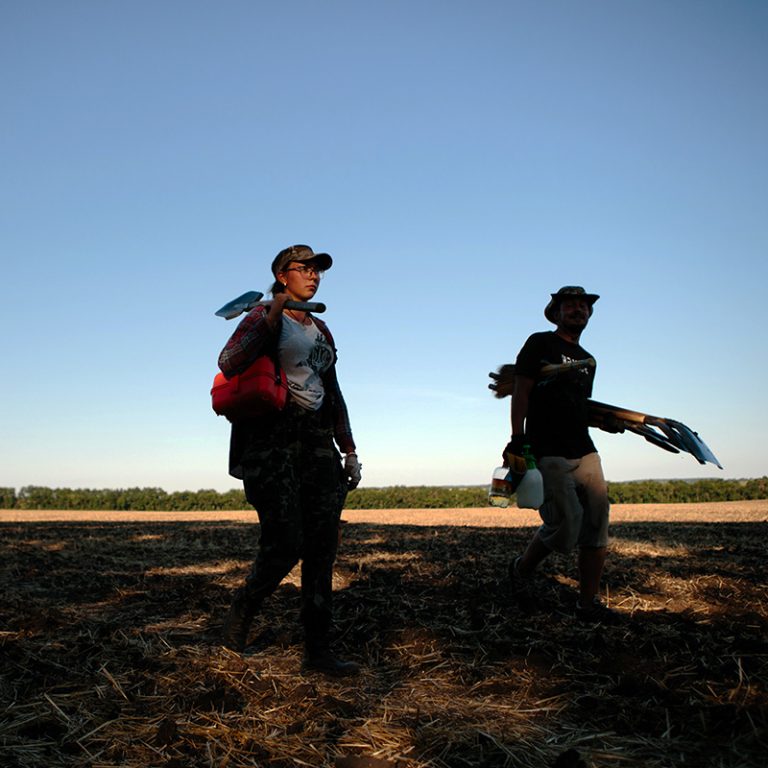For its scale, the Bilsk hillfort in the Poltava region is a paradoxically little-known historic monument. With an area of 5,000 hectares it is probably the largest settlement of the Early Iron Age in Eastern Europe. The historical reserve in Bilsk hides many mysteries left by the Scythians, who inhabited the city of Gelonus described by Herodotus. Tourists come here to see firsthand man-made earthen ramparts and try their hand at excavations. Archaeologists find new valuable artifacts every year, and the Bilsk reserve staff dreams of setting up a museum here.
During the 8th-3rd centuries BC, numerous Scythian tribes lived in the territory of the Great Eurasian steppe. They also settled on the territory of modern Ukraine, founding their fortified settlements, which still impress with their immensity. The territories, where the Scythians once lived, reach Podnipovia, Tavria, Naddniprianshchyna, and as far as the Poltava region.
Their city of Gelonus, mentioned in the works of the ancient Greek historian Herodotus, is often equated by scholars with an ancient settlement near the village of Bilsk in the Poltava region. This settlement, located between the rivers Vorskla and Sukha Hrunia, stretches over 5,000 hectares, and the total length of its ramparts is about 35 kilometres. Because of this, the Bilsk settlement is considered to be the largest monument of the Early Iron Age in Eastern Europe. By comparison, more than 2,500 years ago, Babylon — a Bilsk contemporary — was five times smaller in size, and Rome in the period of Emperor Aurelian (270–275 AD) covered 1,400 hectares.

The territory of the Bilsk hillfort is a complex of three fortifications: Western, Eastern, and Kuzemynskyi. In addition to the preserved earthen ramparts, there are several sites of natural beauty located on its territory and nearby: the wetland Lake Lazky, Kovpakivskyi forest park, Barvinok hill, and preserved tract Zinkivshchyna, among others.
Today the territory of the hillfort is a protected area. Since 2005, the historic and cultural reserve called Bilsk has been here, where new tourists often come and the annual Gelonus Fest takes place. An archeological school is organised here for everyone, and, of course, excavations are carried out as well. In 2021, the building of the former nursery school in the village of Bilsk is planned to be rebuilt into a museum of the Bilsk hillfort, where an archive, an exposition, and a restoration workshop will be set up. Although the research of the Bilsk hillfort’s area has been going on for more than 100 years, there is every reason to believe that the place still hides many secrets and valuable artifacts.

Investigating the history of the Scythians
The city of Gelonus was a powerful trade and economic centre, as it had a lively trade with the ancient polis cities of Prychornomoria (Northern Black Sea coastal area). They were supplied with raw materials, which were of interest to the Greeks and the townspeople (e.g. meat, dried fruits, grains, leather). Thus, wine in amphorae, olive oil, jewellery, and exquisite dishes decorated in the Hellenistic style were brought from the Greek polis. One example is kylikes, ancient wide Greek cups, which archaeologists find in the form of fragments at the excavations of the settlement.
Since 1995, the reserve has had its depository, which is cared for by the chief custodian of funds, Oleh Shaporda. Today there are mainly artifacts of Scythian times: small clay figurines, parts of horse harness, vessels (various types of pots, ladles, and different jars), ritual containers, aryballos (containers for storing aromatic substances — perfumes of that time), spindle whorls (rings put on the spindle to give it weight), arrowheads, household utensils, and other accessories (mirrors, straps, beads). Artifacts, such as ancient Greek amphorae (in 2001, researchers were lucky to find a fully preserved vessel in one of the mounds) and finds of a later period of Kyivan Rus (crosses, knives, metal clasps — fibulae) were brought to the depositary and also preserved.
“Here we perform cameral work on the excavated material. Here, for example, are the things that the expedition on Barvinok hill has recently found — an amphora handle, top parts of stucco pots, vestiges of bronze slag. The latter may indicate that this place once was used as a workshop. Here is a part of the amphora, many different bones, which will be examined by other specialists. All of this will be washed. Then, things of less importance will be taken back, and those of interest will be included in the main fund of the reserve.”
Cameral work
Scientific processing and generalisation of materials obtained as a result of fieldwork.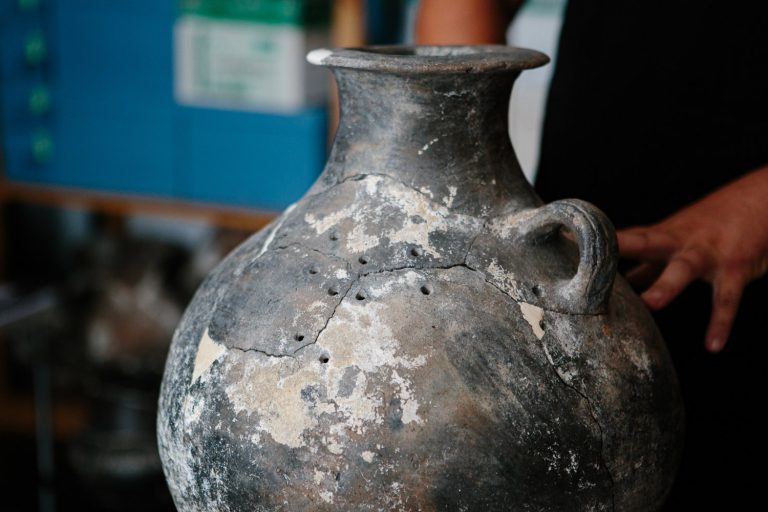
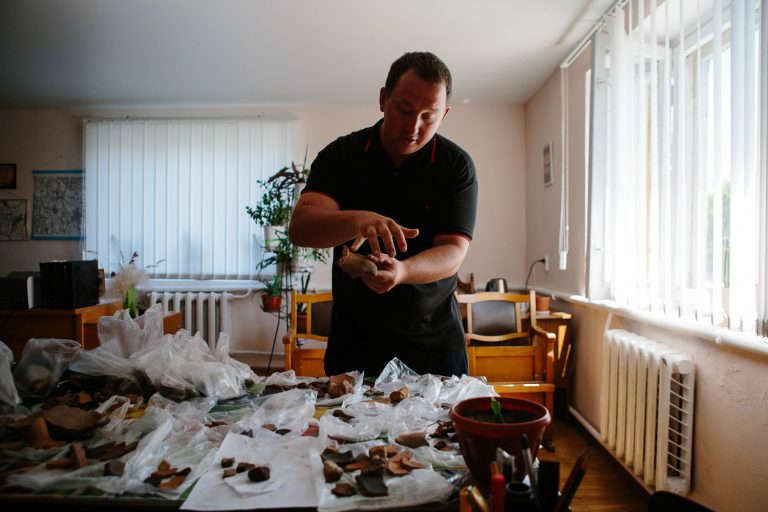
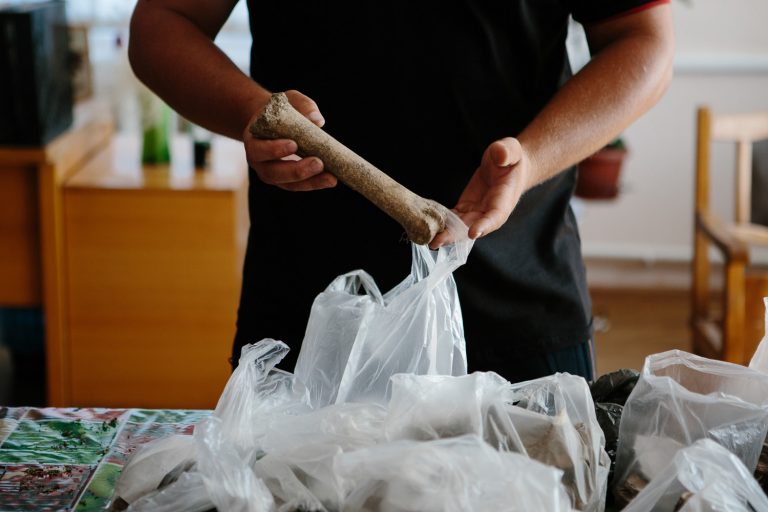
slideshow
Unnecessary items are returned to the same excavation site where they were found. To put them in another place means to create a cultural layer where it does not really exist, and this stands for falsification of culture and history. Valuable objects are sent for restoration to Kharkiv. According to Oksana Doroshenko, a junior researcher at the reserve, this is a very long and costly process.
“These items are investigated by the Kharkiv branch of the National Research and Restoration Centre of Ukraine. Such finds are treated with special substances, and we create conditions for them with the required level of light and humidity. This work is quite laborious and can take months or even years. By simply picking an object you risk it to fall apart. There are even moments when it is necessary to extract it from the excavation together with the ground, to ensure it comes out in one piece.”

Archaeological expedition. Denys Hrechko
The Bilsk hillfort has been studied since the beginning of the 20th century. Archaeologists have found here the remains of a street structure and buildings, confirming the existence of a highly civilised agricultural state in this area. They also managed to find several unique artifacts, such as gold discs, which probably depict the ancient god Dionysus, a bronze cauldron, and Greek amphorae. A gold seal-ring, which was found in 2001 and is exhibited in the Poltava Museum of Local Lore, has become the symbol of the reserve.
Every summer the work of archaeologists is in full swing here. Although the surrounding landscapes have changed over thousands of years, the outlines of the ancient settlement are still quite noticeable — the height of the earthen ramparts sometimes reaches nine metres. Now there are fields around the former Scythian outpost, where locals are engaged in farming. According to Denys Hrechko, head of the archeological expedition in the Bilsk hillfort,, this place was also bustling with life thousands of years ago.
“All ramparts are man-made. They were raised up with hoes, not even shovels, which was very hard work. Remains of many objects were found here: residential, economic, cultural buildings; bronze sculptures, pottery, weaving workshops; altars and temples. Once here, where the forest is now, people worked, prayed, loved, died, and left evidence of their existence in the form of these great ramparts.”
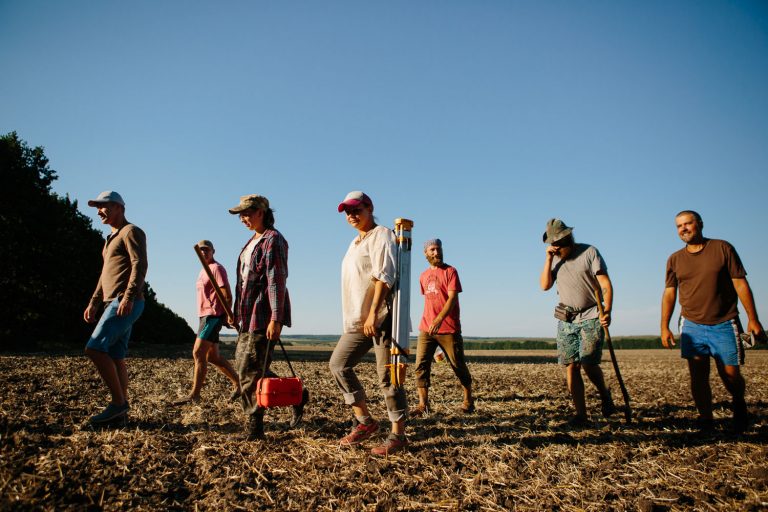
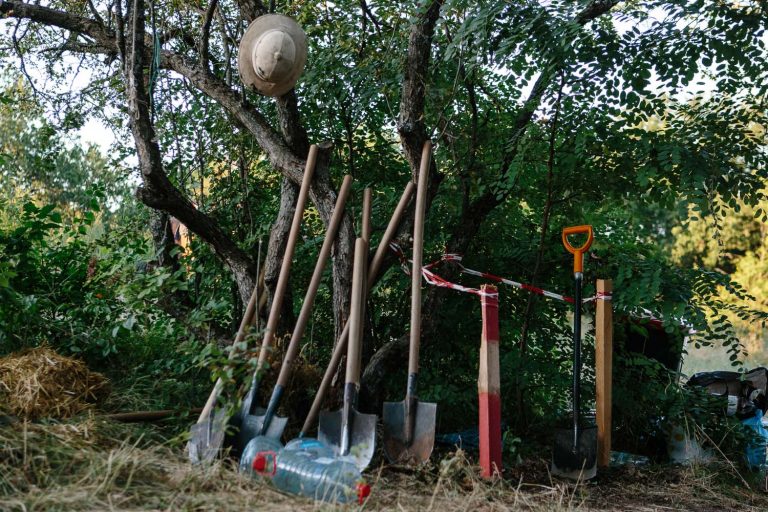
slideshow
The seasonal project of the reserve is the International Summer Field Archaeological School, organised together with the Institute of the National Academy of Sciences of Ukraine, which has been operating here every summer since 2015. You don’t have to be a professional archaeologist to join. People of various professions, as well as volunteers and schoolchildren, supervised by adults, come here. Everyone has an opportunity to study archeology in practice, to live in an archeological camp, to observe the process from the inside along with experts.
Denys Hrechko says that there are very few professional archaeologists in Ukraine now. There are about 300 professionals in the whole country. Considering that archaeologists need to be involved in road construction and other construction work, there may simply not be enough experts for all sites. And if you hire non-professionals who will just dig the ground, more harm than help can be done. Summer school is held in the reserve for as many people as possible to teach them at least the basics of field archeology.
“It is necessary not only to excavate. That is because when we study, we still destroy the cultural layer, and therefore we must be able to take the maximum amount of information. That is why we demonstrate all these stages of field research, and the more people know them, the better it is.”
A working day of the expedition depends on weather conditions. But usually in summer it starts early — at 6 a.m. you should be at the excavation site. During the day, when it is hot, everyone takes a break, and after five or six o’clock in the evening they do the second shift. After that, everyone who worked on the excavation goes to rest, and the archaeologists who prepare the field documentation can stay and make drawings.
“Sometimes we have such situations that we can work from sunset to sunrise because we cannot leave the place unexamined. That is, we have force majeure (for example, a particularly valuable find at the end of the expedition — ed.), so we can work all day long.”
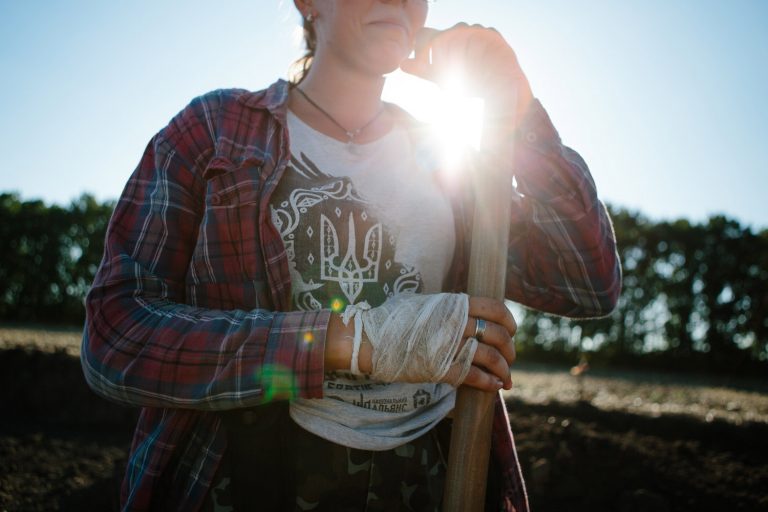
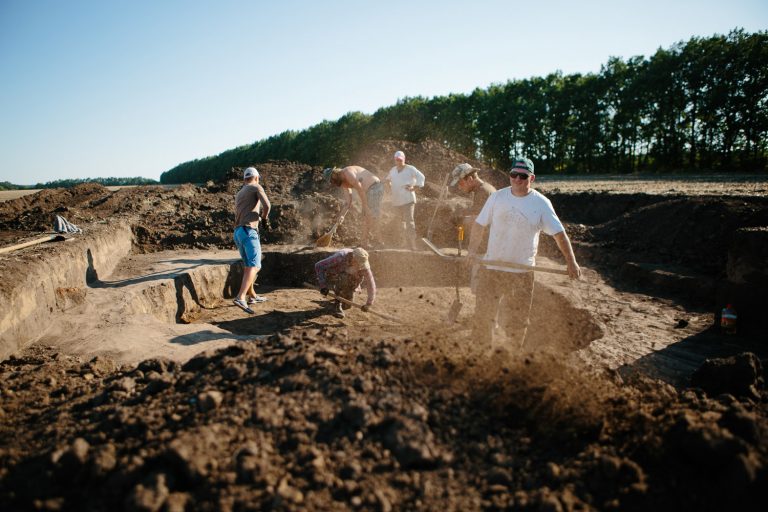
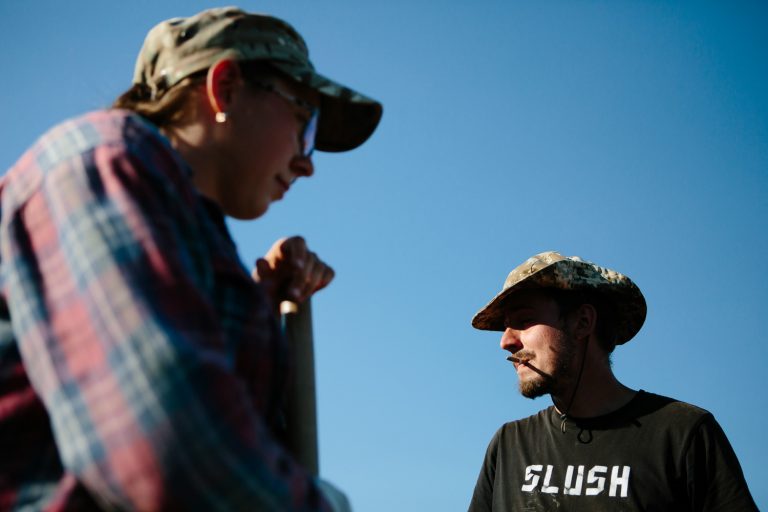
slideshow
Archaeologist Denys Hrechko, Candidate of Historical Sciences, chose his profession when he was a child, as he began to study archeology in a children’s club. He arrived in Bilsk in the fifth grade, during the first of many expeditions in his later life.
Denys Hrechko specialises in the history of the population of the southern part of Eastern Europe in the Early Iron Age and participates in five to six expeditions annually. He describes the work of an archaeologist according to the seasons: excavations are in summer, then analysis of research and scientific reports on their results are done by the end of winter. In spring you need to submit all the material for licensing and submit new applications for research.
“For most people, an expedition is like a vacation in nature: a fireplace, a guitar, a little work. But in fact, this is our job, with physical work in summer, and more office work in winter.”
As a fundamental science, archeology aims to analyse the history of people. After all, from understanding how people lived in the past, you can get tips on how to live in the future.
“Sometimes field research can bring a discovery that fundamentally changes the views on a particular problem. An archaeologist is like a detective who arrives at a crime scene a thousand years later. Accordingly, we are dealing with very fragmented information. The more of these fragments we get, the better we can complete this picture.”
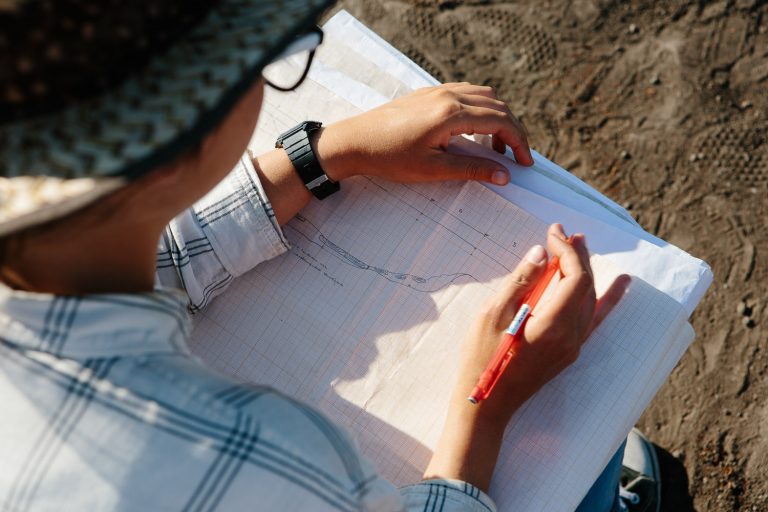
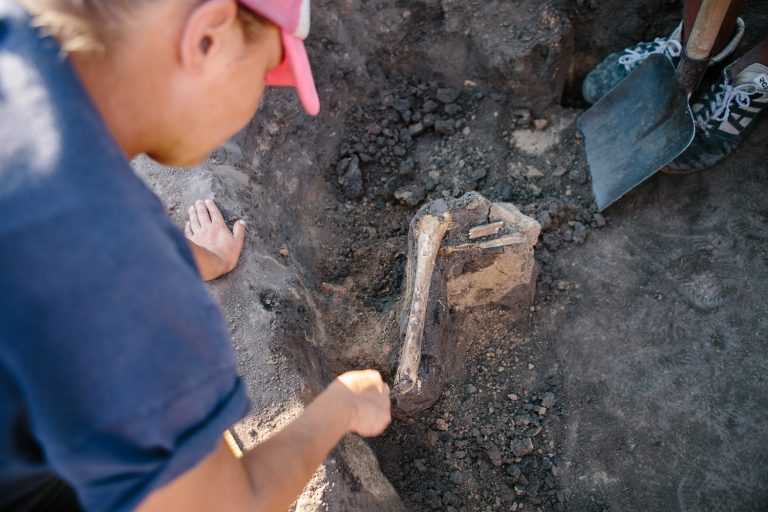
slideshow
Archeology is constantly evolving, so if you compare textbooks in this discipline of different decades, they will vary significantly. And hardly anyone will be able to publish the latest book Ancient History of People that will answer all the questions. At the same time, each new research and discovery helps people to be more interested in their region and to be proud that they live here.
“If people are interested in learning how locals used to live here, what they were interested in and so on, it will make their lives more diverse and fulfilling. And that’s why when people come to us on excursions or just ask us some questions, we don’t turn them away. We tell them what we’re researching, and we try to get them interested.”
Denys Hrechko is sincerely fond of archeology and believes that this is more than work. Rather, it’s a lifestyle.
“People need [to be shown] why they work, why they fight. And this actually should be because of a culture, not just money. You can’t build the national idea for money. Accordingly, people need to see that they have something to fight for, something to improve their lives and their skills for. If everyone does their job as perfectly as they can, we will be fine.”

Developing domestic tourism. Oksana Doroshenko
Every year new tourists who want to see the ancient ramparts firsthand and feel the scale of the settlement come to the Bilsk reserve. Oksana Doroshenko, an employee of the reserve, says that travellers are offered different options for tours: “lazy” tourism by car, cycling, and walking.
“The terrain here changes from plain to more mountainous, so you can see different landscapes: hills, fields, forests, and meadows. As to the distance, the routes can also be of 15, 20, 30, 40 kilometres, depending on the tourists’’ requests. There are also walking tours of 7–10 kilometres. Take a small backpack, water and enjoy the scenery at a slow pace, and at the same time look at the ramparts and get inspired by the atmosphere.”
Usually families or small groups of up to 10 people come here. Some visitors book tours, others travel on their own — they wander the ramparts, go to the excavations, rest.
“People who come demand to be shown something interesting. Ordinary earthen ramparts are not enough for them. They require visualisation of information, reconstruction of ancient houses, models of burials, many information boards, audio guides in several languages. This will then pave the way for the Western tourists. If we want tourism to bring enough money to the budget, we also need to develop the infrastructure.”
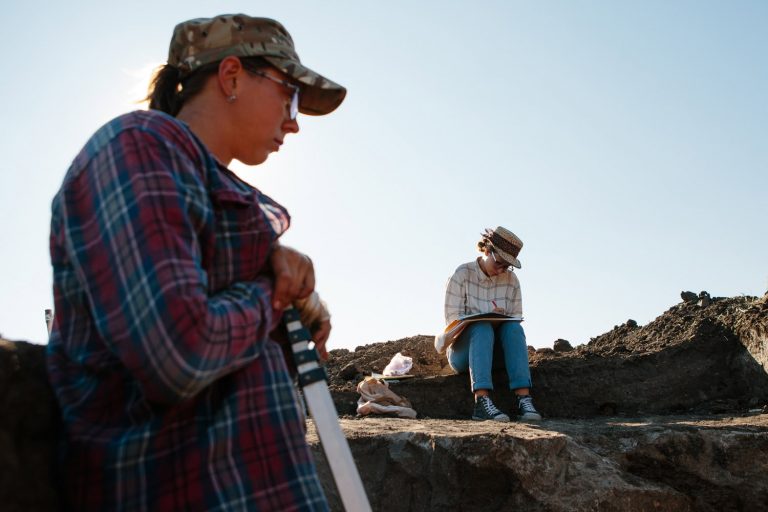
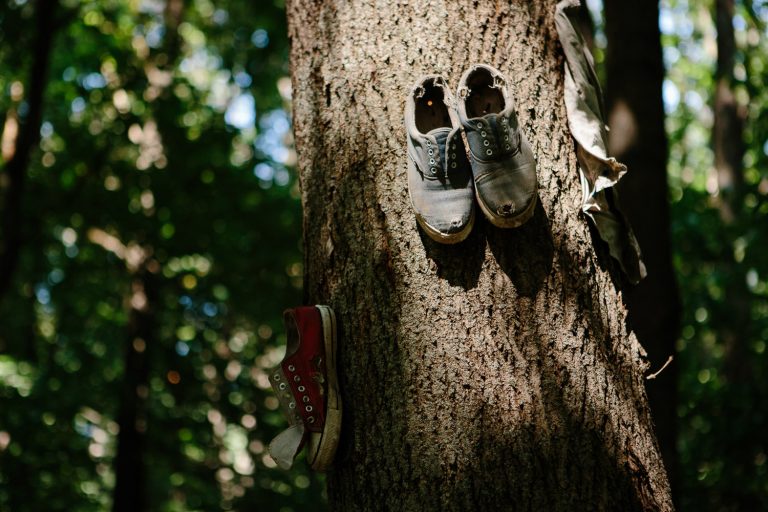
slideshow
Information boards for tourists have been installed on the territory of the Bilsk hillfort. Researchers develop tourist and archaeological maps of the area. It is possible to get acquainted with the discovered artifacts online. There are 3D models and videos of found objects on the website of the reserve.
Organised tourist groups can even join the excavation process in the Bilsk reserve, under the supervision of professional archaeologists, of course.
“People help to clear a household pit or altar and can feel as if they were archaeologists for 5–10 minutes, immersing themselves into this atmosphere. This is what can distinguish us from other similar tourist sites, since archeological excavations are our highlight, which we need to develop and promote.”
The introduction of the annual Gelonus Fest played an important role in promoting the hillfort. According to Oksana Doroshenko, because of the festival many visitors have learned about the Bilsk hillfort when they came here for the first time.
“The idea of the festival appeared in 2017, and, of course, its main goal was to promote the Bilsk hillfort, because the monument is grand, but paradoxically little known.”
Ukrainian music groups that perform ethno, folk, ethno rock, and other styles of music are invited to the festival. At the same time, artisans from all over Ukraine are invited and a so-called “artisan town” is organised (a part of the area where all artisans are located to present their creations).
“Here are carvers and potters, weavers, embroiderers, papercutting — vytynanka — specialists, and motanka rag doll makers. There’s a very diverse range. And our main highlight is the horse show because it is known that the Scythians were skilled riders. We invite historical reenactment enthusiasts who completely reproduce jewellery, household items, and at the same time, there is an impromptu performance.”
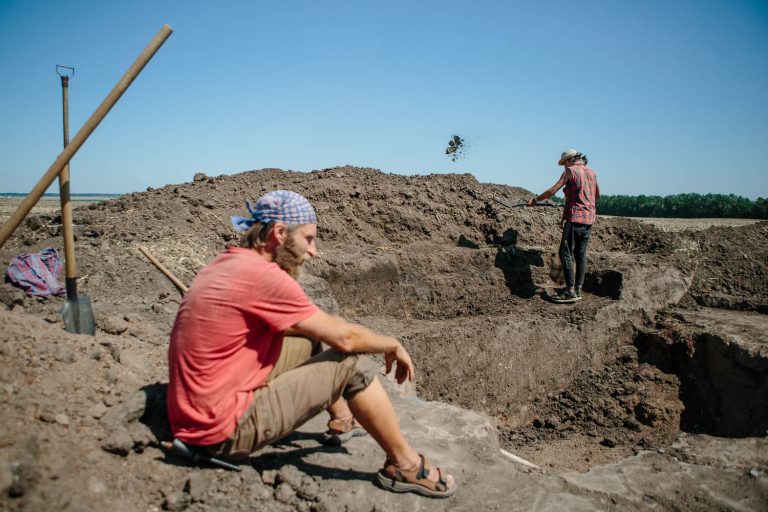
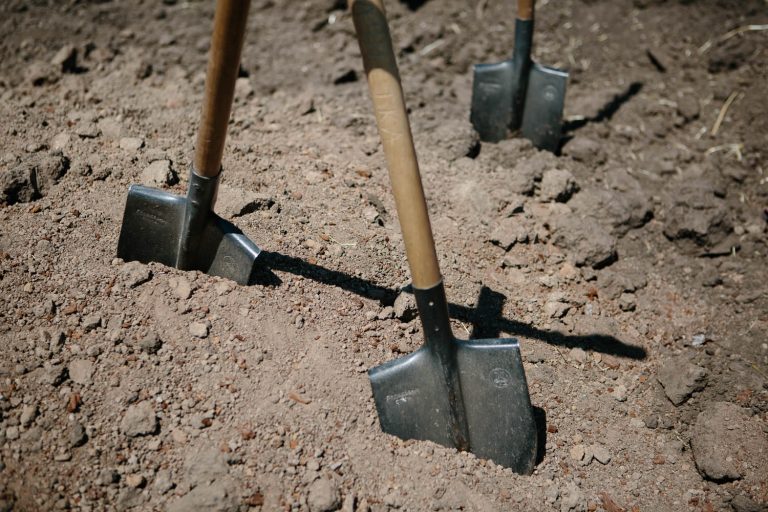
slideshow
During the festival, there is an excavation where archaeologists are constantly on duty, and visitors can not only taste authentic dishes or buy souvenirs but also see the excavation process or even join in.
Oksana Doroshenko says that up to 10,000 visitors came to the festival in 2019. In 2020, the organisers had to cancel the ethno-festival due to quarantine restrictions. However, the experience shows that this event brings results, because both tourists and the media are starting to talk more about the Bilsk hillfort.
“Promotion is what we strive for. To develop our domestic tourism, to develop the reserve, to restore the historical memory. For people to live and know where they live.”
Different paths led each of the reserve’s employees to Bilsk. Oksana Doroshenko has lived in Kotelva all her life, but she learned about the Bilsk settlement by chance, thanks to social media. Working as a lawyer, the woman independently explored and researched her local area, travelled, and engaged in ethnography researching folk crafts, chimneys, and window and gate carvings. She shared the collected information on the internet, adding her impressions. The head of the reserve noticed her public posts and invited her to work.
“I had no idea how to move from jurisprudence to museum work. I wasn’t sure that I would succeed. Then I decided that I would go. I remember our chief custodian took me to the funds. I saw an ancient jar, and I had goosebumps on my skin. To me, it was like an extraterrestrial experience. Ever since, I no longer doubted whether I should be here.”

Oksana Doroshenko has been working at the museum for three years. She conducts excursions, develops domestic tourism in the reserve, and promotes Bilsk’s page on social networks. Oksana feels that she is just beginning to study the settlement, since the people who lived here 2,500 years ago left so many mysteries that in a hundred years you can’t solve them all.
“The nature is so incredible here, with such beautiful plants, birds, and marmots. There is everything in this synthesis: nature, history, archeology. This powerful energy is intertwined in such a whirlpool of feelings, emotions. This is really addictive. If you have already fallen in love with all this, that’s it — it has captured you and will not let go.”
At first, Oksana was only observing archeological expeditions in the reserve as a tourist, but later she also passed the “trial by fire” at the Summer Archaeological School under the leadership of Denys Hrechko. One situation from this studying she remembered significantly well:
“It was evening. We were clearing the child’s burial place and were about to finish. Everyone had already collected their shovels and spatulas, but I kept carefully scratching with my knife. Suddenly I felt something solid and realised that it was no longer a human bone. Indeed, it was a related inventory — a cowry’s shell — very rare for that time. It originates from the Indian Ocean, meaning at that time it had to be transported from there to Greece, then to the polis cities in the Northern Black Sea coastal area, and from there it was already delivered here, to the settlement of Bilsk. That is, what a quest it had taken up. This can only be imagined. The sky was the limit for my joy then!”

